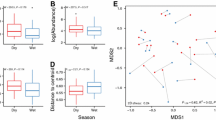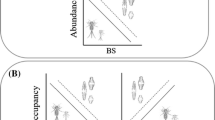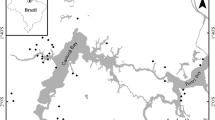Abstract
The positive relationship between species regional distribution and local abundance is one of the most ubiquitous patterns in ecology. Among the hypotheses proposed to explain the relationship, the niche breadth and the niche position (or habitat availability) hypothesis are the most investigated. An unappreciated issue, but that is likely to be important for the understanding the relationship is the nature of variables used to estimate niche measures. Here, we analyzed the form of this relationship in lotic chironomid genera and tested whether niche measures estimated from local and landscape variables explain the observed pattern. Analyses were based in 47 forested streams within Southeastern Brazil. From our data set, we randomly partitioned the data in two non-overlapping sets to estimate taxa distribution and abundance (Distribution Data; n = 23 sites) and to generate niche measures (Niche Data; n = 24). We repeated that process 1,000 times, and for each one, we generated niche breadth and position measures using in-stream and landscape variables and estimated abundance and distribution for each taxa. With these, we estimated the relationship between both abundance and distribution and niche measures using ordinary least-squares regressions. We found no relationship between niche position estimated from local variables and local abundance nor regional distribution. There was a negative relationship between niche position estimated from landscape and local abundance, and regional distribution. We found a positive relationship between niche breadth (local and landscape) and both local abundance and regional distribution. When the relationship was significant, both niche position and niche breadth explained less than a half of total variation in abundance and distribution. This suggests that not only niche-based processes, but also other mechanisms may be responsible for the abundance–distribution relationship in lotic chironomids. A novel finding of this study was that although there was much unexplained variability around the relationships, niche breadth was a better predictor of abundance and distribution than niche position. We suggest that future studies should investigate if spatial processes, like dispersal, together with environmental processes affect interspecific abundance–distribution relationships.




Similar content being viewed by others
References
Blackburn, T. M., P. Cassey & K. J. Gaston, 2006. Variations on a theme: sources of heterogeneity in the form of the interspecific relationship between abundance and distribution. Journal of Animal Ecology 75: 1426–1439.
Broennimann, O., W. Thuiller, G. Hughes, G. F. Midgley, J. M. R. Alkemade & A. Guisan, 2006. Do geographic distribution, niche property and life form explain plants’ vulnerability to global change? Global Change Biology 12: 1079–1093.
Brown, J. H., 1984. On the relationship between abundance and distribution of species. American Naturalist 124: 255–279.
Chase, J. M. & M. A. Leibold, 2003. Ecological Niches – Linking Classical and Contemporary Approaches. The University of Chicago Press, Chicago, IL.
Chave, J., H. C. Muller-Landau & S. A. Levin, 2002. Comparing classical community models: theoretical consequences for patterns of diversity. The American Naturalist 159: 1–23.
Corkum, L. D., 1992. Spatial distribution patterns of macroinvertebrates along rivers within and among biomes. Hydrobiologia 239: 101–114.
Cottenie, K., 2005. Integrating environmental and spatial processes in ecological community dynamics. Ecology Letters 8: 1175–1182.
Death, R. G. & M. K. Joy, 2004. Invertebrate community structure in streams of the Manawatu-Wanganui region, New Zealand: the roles of catchment versus reach scale influences. Freshwater Biology 49: 982–997.
Dolédec, S., D. Chessel & C. Gimaret-Carpentier, 2000. Niche separation in community analysis: a new method. Ecology 81: 2914–2927.
Dray, S. & A. B. Dufour, 2007. The ade4 package: implementing the duality diagram for ecologists. Journal of Statistical Software 22: 1–20.
Ferrington Jr., L. C., 2008. Global diversity of non-biting chironomids (Chironomidae; Insecta-Diptera) in freshwater. Hydrobiologia 595: 447–455.
Frissell, C. A., W. J. Wiss, C. E. Warren & M. D. Huxley, 1986. A hierarchical framework for stream classification: viewing streams in watershed context. Environmental Management 10: 199–214.
Gaston, K. J., 1994. Rarity. Chapman & Hall, London.
Gaston, K. J. & T. M. Blackburn, 2000. Pattern and Process in Macroecology. Blackwell, London.
Gaston, K. J., T. M. Blackburn & J. H. Lawton, 1997. Interspecific abundance-range size relationships: an appraisal of mechanisms. Journal of Animal Ecology 66: 579–601.
Gaston, K. J., T. M. Blackburn, R. D. Gregory & J. J. D. Greenwood, 1998. The anatomy of the interspecific abundance-range size relationship for the British avifauna: I. Spatial patterns. Ecology Letters 1: 38–46.
Gaston, K. J., T. M. Blackburn, J. J. D. Greenwood, R. D. Gregory, R. M. Quinn & J. H. Lawton, 2000. Abundance–occupancy relationships. Journal of Applied Ecology 37: 39–59.
Gonzalez, A., J. H. Lawton, F. S. Gilbert, T. M. Blackburn & I. Evans-Freke, 1998. Metapopulation dynamics maintain the positive species abundance–distribution relationship. Science 281: 2045–2047.
Hanski, I., 1991. Single-species metapopulation dynamics: concepts, models and observations. Biological Journal of the Linnean Society 42: 17–38.
Hanski, I., J. Kouki & A. Halkka, 1993. Three explanations of the positive relationship between distribution and abundance of species. In Ricklefs, R. E. & D. Schluter (eds), Species Diversity in Ecological Communities: Historical and Geographical Perspectives. University of Chicago Press, Chicago: 108–116.
Harcourt, A. H., S. A. Coppeto & S. A. Park, 2005. The distribution–abundance (density) relationship: its form and causes in a tropical mammal order, primates. Journal of Biogeography 32: 565–579.
Heino, J., 2005. Positive relationship between regional distribution and local abundance in stream insects: a consequence of niche breadth or niche position? Ecography 28: 345–354.
Heino, J. & R. Virtanen, 2006. Relationships between distribution and abundance vary with spatial scale and ecological group in stream bryophytes. Freshwater Biology 51: 1879–1889.
Holt, R. D., 1993. Ecology at the mesoscale: the influence of regional processes on local communities. In Ricklefs, R. E. & D. Schluter (eds), Species Diversity in Ecological Communities: Historical and Geographical Perspectives. University of Chicago Press, Chicago: 77–88.
Hutchinson, G. E., 1957. Concluding remarks. Cold Spring Harbor Symposia on Quantitative Biology 22: 145–159.
Hynes, H. B. N., 1970. The Ecology of Running Waters. University of Toronto Press, Toronto.
Leibold, M. A., M. Holyoak, N. Mouquet, P. Amarasekare, J. M. Chase, M. F. Hoopes, R. D. Holt, J. B. Shurin, R. Law & D. Tilman, 2004. The metacommunity concept: a framework for multi-scale community ecology. Ecology Letters 7: 601–613.
Lenat, D. R. & V. H. Resh, 2001. Taxonomy and stream ecology: the benefits of genus and species identifications. Journal of the North American Benthological Society 20: 287–298.
Marchant, R., L. A. Barmuta & B. C. Chessman, 1995. Influence of sample quantification and taxonomic resolution on the ordination of macroinvertebrate communities from running waters in Victoria, Australia. Marine and Freshwater Research 46: 501–506.
McGarigal, K., S. A. Cushman, M. C. Neel & E. Ene, 2002. Fragstats: Spatial Pattern Analysis Program for Categorical Maps. Computer Software Program produced by the authors at the University of Massachusetts, Amherst [available at the following web site: www.umass.edu/landeco/research/fragstats/fragstats.html].
Melo, A., 2005. Effects of taxonomic and numeric resolution on the ability to detect ecological patterns at a local scale using stream macroinvertebrates. Archiv fur Hydrobiologie 164: 309–323.
Metzger, J. P., M. C. Ribeiro, G. Ciocheti & L. R. Tambosi, 2008. Uso de índices de paisagem para a definição de ações de conservação e restauração da biodiversidade do Estado de São Paulo. In Rodrigues, R. R., C. A. Joly, M. C. W. Brito, A. Paese, J. P. Metzger, L. Casatti, M. A. Nalon, N. Menezes, N. M. Ivanauskas, V. Bolzani & V. L. R. Bononi (eds), Diretrizes para Conservação e Restauração da Biodiversidade no Estado de São Paulo. Secretaria do Meio Ambiente & FAPESP, São Paulo: 120–127.
Mouquet, N. & M. Loreau, 2002. Coexistence in metacommunities: the regional similarity hypothesis. The American Naturalist 159: 420–426.
Murphy, J. F. & J. Davy-Bowker, 2005. Spatial structure in lotic macroinvertebrate communities in England and Wales: relationships with physicochemical and anthropogenic stress variables. Hydrobiologia 534: 151–164.
Murray, B. R., C. R. Fonseca & M. Westoby, 1998. The macroecology of Australian frogs. Journal of Animal Ecology 67: 567–579.
Oliveira-Filho, A. T. & M. A. L. Fontes, 2000. Patterns of floristic differentiation among Atlantic forests in south-eastern Brazil, and the influence of climate. Biotropica 32: 793–810.
Pinder, L. C. V., 1986. Biology of freshwater chironomidae. Annual Review of Entomology 31: 1–23.
Poff, N. L., 1997. Landscape filters and species traits: towards mechanistic understanding and prediction in stream ecology. Journal of the North American Benthological Society 16: 391–409.
R Development Core Team, 2006. R: A Language and Environment for Statistical Computing. R Foundation for Statistical Computing, Vienna. http://www.R-roject.org.
Richards, C., R. J. Haro, L. B. Johnson & G. E. Host, 1997. Catchment and reach-scale properties as indicators of macroinvertebrate species traits. Freshwater Biology 37: 219–230.
Schoener, T. W., 1989. The ecological niche. In Cherret, J. (ed.), Ecological Concepts: The Contribution of Ecology to an Understanding of the Natural World. Blackwell Scientific, Oxford: 790–813.
Soininen, J. & J. Heino, 2005. Relationships between local population persistence, local abundance and regional occupancy of species: patterns in diatoms of boreal streams. Journal of Biogeography 32: 1971–1978.
Spies, M. & O. A. Sæther, 2004. Notes and recommendations on taxonomy and nomenclature of Chironomidae (Diptera). Zootaxa 752: 1–90.
Tales, E., P. Keith & T. Oberdorff, 2004. Density-range size relationship in French riverine fishes. Oecologia 138: 360–370.
Thuiller, W., S. Lavorel & M. B. Araujo, 2005. Niche properties and geographical extent as predictors of species sensitivity to climate change. Global Ecology and Biogeography 14: 347–357.
Umetsu, F., J. P. Metzger & R. Pardini, 2008. Importance of estimating matrix quality for modeling species distribution in complex tropical landscapes: a test with Atlantic forest small mammals. Ecography 31: 359–370.
Venier, L. A. & L. Fahrig, 1996. Habitat availability causes the species abundance–distribution relationship. Oikos 76: 564–570.
Vinson, M. R. & C. P. Hawkins, 1998. Biodiversity of stream insects: variation at local, basin, and regional spatial scales. Annual Review of Entomology 43: 271–293.
Warren, P. H. & K. J. Gaston, 1997. Interspecific abundance–occupancy relationships: a test of mechanisms using microcosms. Journal of Animal Ecology 66: 730–742.
Wiens, J. A., 2002. Riverine landscapes: taking landscape ecology into the water. Freshwater Biology 47: 501–515.
Williams, C. B., 1960. The range and pattern of insect abundance. American Naturalist 94: 137–151.
Acknowledgments
We thank Joaquín Hortal and Professor José Alexandre Diniz-Filho for their valuable comments during the elaboration of this study. Adriano S. Melo, Karl Cottenie, and an anonymous referee provided important criticism in an early version of this manuscript and we also thank them. Financial support was provided by the Brazilian Council for Scientific and Technological Development (CNPq) to T. Siqueira and L. M. Bini, and by The State of São Paulo Research Foundation (BIOTA/FAPESP) to F. O. Roque and S. Trivinho-Strixino.
Author information
Authors and Affiliations
Corresponding author
Additional information
Handling editor: David Dudgeon
Rights and permissions
About this article
Cite this article
Siqueira, T., Bini, L.M., Cianciaruso, M.V. et al. The role of niche measures in explaining the abundance–distribution relationship in tropical lotic chironomids. Hydrobiologia 636, 163–172 (2009). https://doi.org/10.1007/s10750-009-9945-z
Received:
Revised:
Accepted:
Published:
Issue Date:
DOI: https://doi.org/10.1007/s10750-009-9945-z




